|
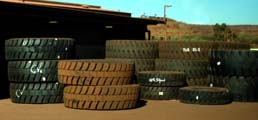
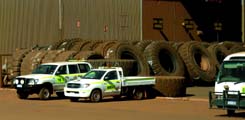
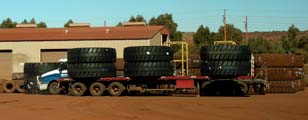
One of the first stops is the tyre store, holding approximately
$2 million of tyres at any given time.
Each tyre cost $25'000 and last between 9-12 months.
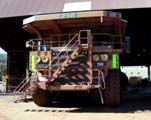
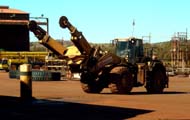
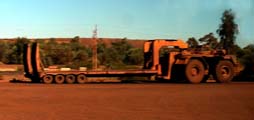
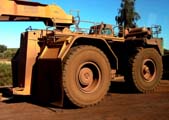
tyres can measure up to 3.6 metres in diameter and weigh
up to 5 tonnes with the rims inserted.
To move them around special vehicles are required.
Each truck tyre can carry a 60 tonne load.

Then we head up to the first lookout giving a good view
of the crusher, the beneficiation plant and the railroad
loading facility.
The power station is gas fired using a 47 km spur line from
the Karratha to Kalgoorlie gas pipeline, which can generate
up to 105 megawatts of power.
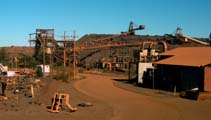
|
Waste rock from the mine, which is low in iron content,
is retained for use in rehabilitation.
A beneficiation plant was built at Mt Whaleback in
1979 to retrieve the ore mixed in with waste, providing
an additional 8 Mtpa (million tonnes per annum) for
sale.
The beneficiation plant separates ore and waste. Ore
that is mixed with waste is tipped into crusher no.
3.
Once the ore is crushed it travels along a conveyor
belt where the ore is processed by both wet and dry
sorting.
|
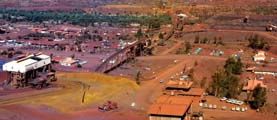
|
Crusher No. 2 is the primary crusher.
The crusher breaks down ore boulders of up to 1.5 metres
in diameter into lumps about the size of a football.
It is then transferred to a secondary crusher, where
it is broken down into grapefruit-sized lumps.
Once the ore is crushed it is stockpiled on one of
the two 'Live' stockpiles, each of which has a load
out tunnel underneath with 13 gravity fed chutes.
This is where the trains are loaded at the rate of
14'000 tonnes per hour.
|
The first trainload of iron ore left Newman in 1969
and the first shipment left Port Hedland in April 1969
bound for Japan. Since then over 1 billion tonnes of ore
has been railed out of Newman.
The 426-kilometre railway line from Newman to Nelson Point
is one of Australia's longest privately owned railways. The
company has more than 80 locomotives and more than 3'300
ore cars, which represent a major investment.
All train movements are managed from a traffic control
centre at Port Hedland.
Specialised computer software and digital communications
powered by solar technology, control train movements, warn
about unsafe conditions and weigh the ore cars as they pass
by.
An average train measure 2.4 kms long, consisting of four
to six 4'000 horsepower locomotives, 208 to 300 ore cars
and one driver.
Each car holds approximately 115-120 tonnes of ore.
Loading time is approximately 45 minutes and when fully loaded
a train will weigh approximately 30'000 tonnes and can reach
up to 65kms/ph with a breaking distance of 3kms.
The trains are up to 3.75 kilometres long and the journey
from Newman to Port Hedland takes approximately eight hours.
In June 2001, BHP Billiton Iron Ore set a record for
the world's longest and heaviest train.
Comprising eight locomotives and 682 ore cars, it measured
7.353 km and weight 99'732.1 Tonnes.
It carried a world-record net mass of 82'262 Tonnes of iron
ore, over a distance of 275 km from the mines to Port Hedland.
Then we are driven to the lookout into the open-cut mine.

Well, we thought that the mine at Kalgoorlie was big, but
Mt. Whaleback is much bigger!
Mt Whaleback is the largest Single Open-Cut Iron Ore mine
in the world - currently 5.5km long and 1.5km wide.
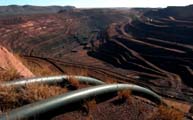
|
Iron Ore was discovered by Stan Hilditch in 1957 and
mining Commenced in 1968 after a Commonwealth Embargo
was lifted.
The Mt Whaleback seam is approximately 1.6 billion
tonnes.
It still has more than 20 years of mine life remaining.
Mt Whaleback was originally 805 metres above sea level,
currently it is mined down 420 metres.
The steps on the sides of the pit are called benches
- each bench is 15 metres high.
The water table starts at bench 18 - currently mining
on bench 28.
80 million litres or water is pumped out each week
and used in the beneficiation plant, water carts and
drill rigs
|
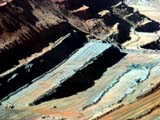
|
The company uses the open-cut method of mining, which
involves drilling holes into the pit floor and inserting
explosives to break up the solid rock. Blasting takes
place four or five times a week, depending on production
requirements.
Drill rigs drill 15m deep and when ready to blast
each hole is filled with approximately 1 tonne of ANFO
explosive which is Ammonium Nitrate and 6% diesel.
After blasting, excavators scoop up to 63 tonnes of
iron ore and load it into haul trucks - which can carry
as much as 240 tonnes - to be transported to the primary
crusher.
|
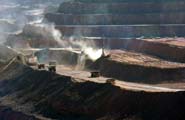
|
The machines used are:
Brutus
A 120 tonne haul pack converted into a tow truck -
can tow ore trucks or carry up to 130 tonnes of machinery
on a truck tray.
Water Carts
They hold 104'000 litres of water taking approximately
3 hours to empty.
they are used for dust suppression on the mine roads.
Drill Rigs
They are used to drill for exploration and blasting,
weight 110 tonnes
|
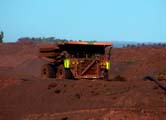
|
Ore Trucks
The mine currently has 12 x 190 tonne trucks and 36
x 240 tonne trucks in its fleet, due to reach a total
of 63 by the end of 2007.
Ore trucks are made by Caterpillar, mechanically
driven with 6 gears forward and 1 reverse, automatic.
Truck cabs have 2 way radios, air conditioning, power
steering, dust suppression kits and a CD Player.
|
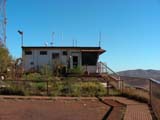
|
"The Whitehouse" co-ordinates the Modular
Mining System - this is a GPS system that tracks all
the machinery in the pit.
The Whitehouse can determine the position of each machinery
with a 10cm accuracy at all times
Information provided by this system includes the weight
of the ore carried by the trucks, their speed, fuel
levels and how the machine is running mechanically.
The type of ore mined at Mt Whaleback is Brockman
Hematite - which is 68.8% iron and blue grey in colour
and is one of the highest grades in the world.
Ore is blended to 65.1% using another ore called Goethite
Limonite, which is 61% iron and ochre in colour.
|

|
The Iron Ore is exported to steel makers in Japan,
Korea, Taiwan, China, Europe and Australia through
Port Hedland, which is one of the busiest commodity
ports in the world.
Two separate port operations are located on opposite
sides of the harbour, at Nelson Point and at Finucane
Island.
Ore from Mt Whaleback is sent to Nelson Point, while
Finucane Island receives ore from other mines.
A sophisticated conveyor system runs under the harbour,
through a 1.16 kilometre tunnel that carries ore from
Nelson Point to Finucane island.
The port is capable of handling four ships at a time,
each up to 320 metres long and carrying up to 220'000
tonnes of ore.
|
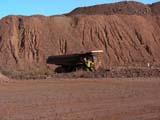
|
The ore is unloaded from the trains into one of three
car dumpers, screened and being put into stockpiles.
Each stockpile contains about 200'000 tonnes and is
about 200 metres long and 15 metres high.
Giant bucket-wheel reclaimers scoop up the ore from
the stockpiles and transfer it to a conveyor system,
which carries it to the ship-loaders.
A ship-loader can load at a rate of up to 10'000 tonnes
an hour. On average, it takes about 35 hours to load
a ship and more than 600 ships are loaded each year.
|
|